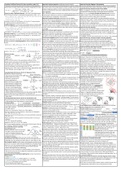Overig
Cheat Sheet for Data Mining for Business and Governance (880022-M-6) Exam
Cheat Sheet with all necessary information to pass the exam of "Data Mining for Business and Governance (-M-6)" at Tilburg University. The course is part of the Master Data Science and Society. It was taught in the academic year 2021/2022 in semester 2, block 3 (January to March 2022) by the lectur...
[Meer zien]














